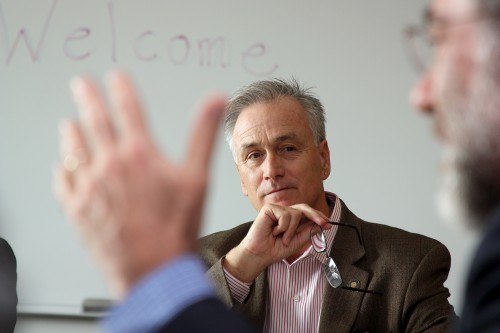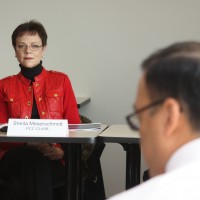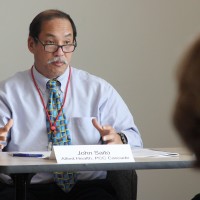This content was published: October 26, 2012. Phone numbers, email addresses, and other information may have changed.
Congresswoman Bonamici orchestrates health information roundtable at PCC
Photos and story by James Hill
On Thursday, Oct. 25, Congresswoman Suzanne Bonamici (OR-1) gathered dozens of movers-and-shakers from the healthcare industry, local government and education realm for a roundtable discussion at the Willow Creek Center. She queried and listened to experts about workforce training issues in the implementation of health information technology (HIT).
“There are a lot of things I love about Oregon and it’s always great to be able go back to Washington, D.C., and talk about the great things we are doing here,” the Congresswoman told the group. “And one of those is our health care transformation and certainly HIT is a big part of that. I want to have a discussion of how I can, in a federal role, be of assistance as we are looking to fill these needs.”

State Rep. Chris Harker listens to health care leaders during Congresswoman Suzanne Bonamici’s health information roundtable at Willow Creek on Oct. 25.
With that impending health care transformation in Oregon, effective use of electronic health care records (EHRs) and HIT systems will be a vital component of coordinating care, she said. Training workers who develop and use HIT properly will help ensure that the transition to electronic systems is cost effective and promotes improvements in patient care.
“Health information technology is a growing field with the potential to create new family wage jobs in Oregon,” Bonamici said. “We need to make certain that our educational institutions are collaborating with technology development companies and medical providers so that students are prepared for available positions.”
Roundtable participants discussed how to prepare medical service providers to effectively use HIT systems and how to train technology developers to meet the needs of the medical industry. John Saito, dean of Allied Health at the Cascade Campus, threw in his two cents worth.
“We are trying to get health status information from every level of provider,” Saito said of PCC’s efforts. “The ground-level intelligence that we’re getting from these workers has been very critical. In developing these standards, from the community college perspective, we should not forget every individual that can contribute the necessary information in deciphering a patient’s symptom.”
In addition to Saito, on hand was a Who’s Who of local leaders: State Rep. Chris Harker; Carol Robinson, Administrator, Oregon Office of Health Information Technology; Bridget Barnes, Vice President & CIO, OHSU; Dawn Bonder, Director, OHITEC; Dr. Homer Chin, Associate Medical Director, Clinical Information Systems, Kaiser Permanente; Gary Coleman, Employment Specialist – Business & Computer Technologies, at the Sylvania Campus; Dr. Bill Hersh, Chair, Department of Medical Informatics & Clinical Epidemiology, OHSU; Jo Isgrigg, Executive Director, Oregon Healthcare Workforce Institute; Dr. John Kenagy, Senior Vice President & CIO, Legacy Health Systems; Kim Lamb, Executive Director, Oregon Health Network; Luis Machuca, President & CEO, Kryptiq; Sheila Meserschmidt, Director of Health Care Programs with CLIMB; Paul Wild, Business & Industry Workforce Training, Mt. Hood Community College; Scott Zacks, Workforce Development Chair, HIMSS Oregon; Sarah Tillery, PCC’s service-learning coordinator; and Tracy Zitzelberger, Administrative Director, Oregon Center for Aging & Technology.







“We are trying to get health status information from every level of provider,” Saito said of PCC’s efforts.
What exactly does this passage mean?
It means each heath care worker (nurses, physios, doctors…etc.) that treats you will be able, or should be able, to provide information to your e-file as your condition changes during your stay/visits.
How will this information gathering process be transparent to patients? Will patients have direct involvement in managing the information system that they are part of? Will patients have full access to their own health care records? Will they have the ability to comment as part of their own records- to disagree with a diagnosis, to explain symptoms more clearly, etc?
If you aren’t doctor or health care provider, not sure why you should have the ability to access/manage a health record. But maybe good questions for those leading the HIT charge.
Medical records have several uses, including filtering for types of care, health care status, medication status, on and on. As a consumer, I’m concerned that the way information is collected and presented will affect decisions on my health care. I think a well designed system will include the input of consumers at multiple points. How can consumers be involved in this ‘HIT’ process today?
Thanks for your reply.
As RN this means that Dr’s orders are more legible and electronically signed , pharmacy, consultant, nursing, physical therapy and all others involved in the care of the patient have access + are able to log on and get an update. It means the consultant does not need to repeat tests but can check them out and proceed from there so is able to arrive at a diagnosis faster. Cuts cost due to less repetition, Patient has assurance of all involved in the treatment are ” on the same page”. More insurances have started checking as well and they are able to see the necessity of doing the procedure, without a fight as to having to explain to get them to pay.The Hippa law protects and guards against unauthorized access. It also means people cannot abuse the system and go from one hospital to another to get treated for same problem and receive, for example, pain pills, so drug users will have harder time getting supplies. (But then, I had to give a urine test to prove I am drug-free to get a job, so maybe this will lead more to be drug-free to get the freebies?! )
Patient access to their own records, in addition to their communicating with all the health care providers involved in their care, is critical in health informatics systems. My statement above was that as we move into coordinated care organizations in Oregon, there will be other health care providers, yet to be determined, that will be involved in the care of each patient. At this point, they fall under a category known as non-traditional health care workers, and their job descriptions, for whom they work, and their compensation is not known .. yet. Hope that helps, Elmer.
In addition to HIPAA (Health Insurance Portability and Accountability Act), there are new exciting incentives for Medical Professionals to adopt “authorized” electronic systems. The new HITECH law (extension of HIPAA) has specific policies and procedures in place to help keep PHI safe to unauthorized users and to streamline the availability for those who do have authorization (MD, NP, RN,..etc). (HealthIT.hhs.gov)
[…] gathered dozens of leaders from the healthcare industry, local government and education realm for a roundtable discussion at Willow Creek about workforce training issues in the implementation of health information technology. Last […]